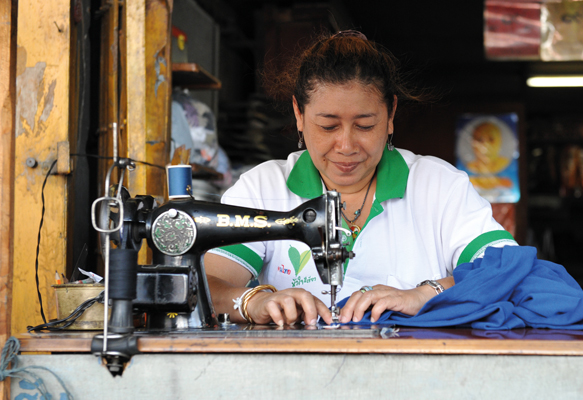Microfinance: A motor for development?

A key step in the process of binding holy books is the pressing stage. After putting the pages into place and gluing on a decorated cover, you need to apply pressure to the book to ensure that the cover sticks. At its most basic, you simply apply weights. However, this method isslow and unreliable.
For one family business in the Indian city of Kolkata, the solution was to buy a clamp-like book press which would allow them to press more books more reliably and in less time – and therefore grow their business. The only problem was that a book press can cost a few hundred dollars – capital to which they didn’t have access. The solution? A small loan from a local microfinance institution (MFI).
Dr Sohini Kar, an anthropologist at the London School of Economics (LSE) spent a year studying the effects of MFIs in Kolkata. Among the many borrowers she interviewed, the book binding business was something of a success. The couple in question had used their loan to buy a book press, which allowed them to increase profits and, during periods of high demand during holy festivals, hire additional labour to their workshop.
At first glance, this story highlights the potential of microfinance, which is best known for its focus on lending small sums to entrepreneurs in poor countries who cannot access traditional sources of credit. However, Dr Kar notes a word of caution: “Despite being a success story, [the bookbinders] still only make about 10,000 Rupees per month – the equivalent of $2 per day. This business still hasn’t got them out of poverty.”
Since emerging in the 1970s, there have been high hopes for microfinance as a tool to alleviate poverty. However, as the concept has evolved over time, its efficacy has been questioned. What is the state of the microfinance industry today, and how is it evolving?
The microfinance movement
Microfinance initially gained traction in the 1970s (although there have been precedents) and is perhaps most associated with 2006 Nobel Peace Prize-winner Muhammad Yunus and his Bangladeshi MFI – Grameen Bank. Microfinance aims to provide a range of financial services to people without access to traditional financial services – around 1.7 billion people worldwide still don’t have a regular bank account according to The World Bank.
Microfinance is closely associated with micro-credit – small loans to help business owners. Rupert Scofield, President, CEO and co-founder of FINCA International, a leader in the microfinance field, explains how the concept was revolutionary when he first became involved in microcredit. “I didn’t realise at the time but we were at the forefront of a disruption of the entire financial sector in developing countries.”
Mr Scofield was a volunteer with Peace Corps, a US government overseas aid programme, and was posted to Guatemala in 1971. He noticed that banks in Central America only really catered to the elite. “Part of my job was to work with agricultural co-ops. The farmers I was working with were very capable, yet they had no money to purchase new inputs. However, when given a small loan of around $50, they could purchase fertiliser and dramatically improve yield, eat better and sell on their surplus.”
Mr Scofield recounts that of the 800 farmers his Peace Corps project initially provided loans to, 799 repaid their loan in full. An idea was born, and Mr Scofield went on to co-found FINCA, which has proved highly successful, with a presence around the globe.
Since then, microfinance has evolved dramatically and there’s now a huge range of players offering financial services to people who don’t have the necessary collateral to use formal banking. These include purely commercial MFIs, NGOs and even governments – offering small loans, savings accounts, insurance and investment. BNP Paribas, the French bank, estimated that there were 123 million MFI customers around the globe in 2016, and a loan portfolio of around $102bn. Most customers are in India, followed by Vietnam, Bangladesh, Peru and Mexico.
Empowering women
Besides providing financial services to the poor, microfinance is also well known as a tool for women’s empowerment – 84% of all borrowers are women living in rural areas, according to BNP Paribas.

Mr Scofield describes a typical FINCA client: “First and foremost she is probably a woman aged between 30 and 50. She normally has a family and her husband works – possibly abroad and sending back remittances. So, very often she may effectively be a single mother, supporting three or four children.” This customer will typically stitch a living together, through activities such as selling produce on a local market, preparing and selling cooked goods or sewing, with her husband’s remittances supporting that. MFIs can therefore offer a lifeline of credit to either re-invest in her activities, or by helping save for a rainy day.
Why do MFIs overwhelmingly serve women? First, there’s a perception that women make more dependable borrowers. Many MFIs report that women are more likely to repay their loans on time and in full, while they also are less likely than men to squander the money on entertainment or luxuries. Women tend to spend the cash either on a small enterprise or on things which will help their families, such as medical treatment or education. Women have also traditionally been excluded from more formal credit.
Issues arising
For the first couple of decades of its existence, there was significant optimism around microfinance, with the United Nations naming 2005 the year of microcredit. Microfinance was designed to be a win-win model. In its ideal form, lenders provide loans to small businesses who invest the money and grow their businesses – lifting them out of poverty, boosting the local economy and hiring staff. At the same time, lenders make money on their advances.
However, as with any disruptive business model, after the initial optimism, issues with the model have been raised.
Professor Aneel Karnani of the University of Michigan’s Business School has been a leading critic of the concept over the past decade. His concern about microcredit in particular is that it assumes that people in developing countries are all entrepreneurs who just need a little cash to start their business: “Ask a poor person what the one thing they want in life is. They will almost always tell you they want a good, steady job. When we talk about entrepreneurship in the West, we think of innovation, creativity, persistence and vision. Most people in the world are not entrepreneurs – they’d much rather have a stable salary, getting paid at the end of the month.”
Professor Karnani points to rich countries with high education levels and infrastructure that supports entrepreneurialism: “Even there, 90% of people work on a salary, and only around 10% are self-employed. And if you take away the 5% who are doing jobs, like electricians or plumbers who aren’t really entrepreneurs, less than 5% of people are truly business-minded.”
For Professor Karnani, microcredit should not be viewed as a solution for combatting poverty and cautions against romanticising people in developing countries as budding entrepreneurs. When there is little access to specialised education and training, the chances of developing a unique business idea are low. He warns that in many cases, the kinds of businesses MFIs fund normally have low profits and are unlikely to solve entrenched poverty.
For sceptics like Professor Karnani, the solution is simple: more and better jobs. Although lending to would-be entrepreneurs can provide opportunities that might otherwise be hard to come by, industries which hire large numbers of people should be a leading priority.
Research by Dr Sohini Kar of LSE highlights other problems with idealised notions of microfinance. In her research, she found that all too often loans were used for consumption – rather than investing in a business. Borrowers would use the loan for fixing a roof or spending on a child’s school fees. Certainly valuable, yet far from entrepreneurial.
While most MFIs follow the highest standards, Dr Kar’s research found that some of the institutions she studied in Kolkata had room for improvement. For instance, some loan officers used more than just a borrower’s financial situation when deciding to make loans. Dr Kar went on visits with individual loan officers who told her how factors such as the cleanliness of a home or the religious background of the borrower were also counted into their personal assessments of creditworthiness.
Of course, not every MFI is the same, and industry initiatives have been set up that encourage lenders to follow responsible client protection standards. Nevertheless, there have been calls for greater transparency and external regulation of the sector.
Hammers and nails
So how do these criticisms stand up when microfinance is taken as a whole? Mr Scofield of FINCA believes that microfinance should be looked at as a tool: “It’s like saying a hammer doesn’t work – if you mess up hitting a nail, of course it won’t work. But like any tool, if its used correctly, it has impact.”
For Mr Scofield at least, microfinance never was intended to resolve all the problems of the world: “My view is that if a whole country is to be lifted out of poverty, it will require a cross-sector effort, with big companies creating value-added jobs, just as happened in the US and Europe. It’s virtually impossible to expect microfinance to do that.”
In an ideal world, poverty would be reduced with more formal jobs and a better social safety net. “But let’s be honest, in the past few decades the formal economy hasn’t provided this in most developing countries,” Mr Scofield argues: “This means that the majority of people are still left to find the solutions to their own problems – and microfinance is one of the few resources helping them to do that.”


